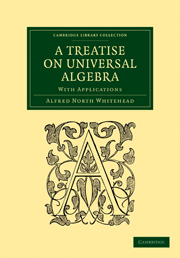Book contents
- Frontmatter
- PREFACE
- Contents
- BOOK I PRINCIPLES OF ALGEBRAIC SYMBOLISM
- BOOK II THE ALGEBRA OF SYMBOLIC LOGIC
- BOOK III POSITIONAL MANIFOLDS
- BOOK IV CALCULUS OF EXTENSION
- BOOK V EXTENSIVE MANIFOLDS OF THREE DIMENSIONS
- CHAPTER I SYSTEMS OF FORCES
- CHAPTER II GROUPS OF SYSTEMS OF FORCES
- CHAPTER III INVARIANTS OF GROUPS
- CHAPTER IV MATRICES AND FORCES
- BOOK VI THEORY OF METRICS
- BOOK VII APPLICATION OF THE CALCULUS OF EXTENSION TO GEOMETRY
- Index
CHAPTER I - SYSTEMS OF FORCES
Published online by Cambridge University Press: 29 August 2010
- Frontmatter
- PREFACE
- Contents
- BOOK I PRINCIPLES OF ALGEBRAIC SYMBOLISM
- BOOK II THE ALGEBRA OF SYMBOLIC LOGIC
- BOOK III POSITIONAL MANIFOLDS
- BOOK IV CALCULUS OF EXTENSION
- BOOK V EXTENSIVE MANIFOLDS OF THREE DIMENSIONS
- CHAPTER I SYSTEMS OF FORCES
- CHAPTER II GROUPS OF SYSTEMS OF FORCES
- CHAPTER III INVARIANTS OF GROUPS
- CHAPTER IV MATRICES AND FORCES
- BOOK VI THEORY OF METRICS
- BOOK VII APPLICATION OF THE CALCULUS OF EXTENSION TO GEOMETRY
- Index
Summary
Non-metrical Theory Of Forces. (1) The general theory of extensive manifolds, apart from the additional specification of the Theory of Metrics, has received very little attention. It is proposed here to investigate the properties of Extensive Manifolds of three dimensions, thereby on the one hand illustrating the development of one type of formulae of the Calculus of Extension, and on the other hand discussing properties which are important from their connection with Geometry.
(2) Since in this case four independent points define the complete region the simple extensive magnitudes are only of three orders, the point, the linear element, the planar element. Also the only complex extensive magnitudes are systems of linear elements. A linear element,—in that (α) it is an intensity associated with a straight line, (β) it is directed along the line, so as to be capable of two opposite senses, (γ) it is to be combined with other linear elements on the same line by a mere addition of the intensities [cf. § 95 (1)],—has so far identical properties with a force acting on a rigid body. Only in an extensive manifold no metrical ideas with respect to distance have been introduced. The other properties of a linear element, whereby it is defined by two points and is combined with other linear elements on other lines form a generalization of the properties of a force so as to avoid the introduction of any notion of distance. It will be noticed that the theorem respecting the combination of Forces known as Leibnitz's theorem expresses the aspect of the properties of forces which are here generalized.
- Type
- Chapter
- Information
- A Treatise on Universal AlgebraWith Applications, pp. 273 - 283Publisher: Cambridge University PressPrint publication year: 2009First published in: 1898

